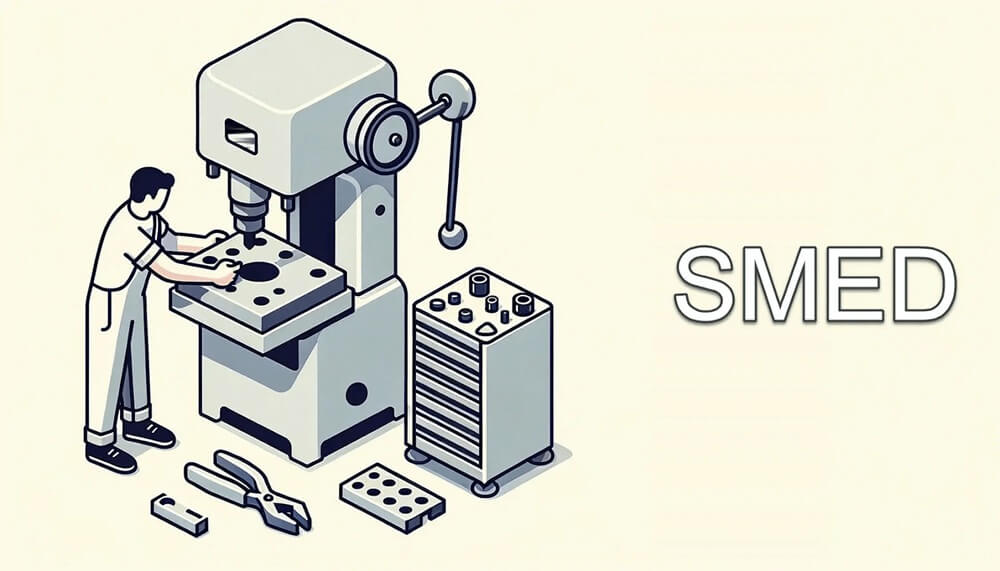SMED là gì? 5 bước áp dụng thành công phương pháp SMED trong sản xuất
SMED stands for "Single Minute Exchange of Die," which is a systematic approach and methodology for reducing setup or changeover time in manufacturing processes. It was developed by Shigeo Shingo, a Japanese industrial engineer and consultant, and is widely used in lean manufacturing and continuous improvement initiatives.
The essence of the SMED system is to convert as many changeover steps as possible to “external” (performed while the equipment is running), and to simplify and streamline the remaining steps. The name Single-Minute Exchange of Die comes from the goal of reducing changeover times to the “single” digits (i.e., less than 10 minutes).

SMED has emerged as a key element in lean manufacturing due to the increased productivity and reduced downtime it creates. In today’s evolving industry landscape, SMED is on the rise as we move towards a more data centric era.
It is essential for organizations to embrace this approach and combine it with state of the art technologies to enhance agility, responsiveness and competitiveness. Incorporating SMED is not just an option, it’s a must have for those aiming to excel in the future of manufacturing.
Benefits of using SMED
Smaller batch sizes and reduced inventory levels
SMED can help your manufacturing teams work with smaller lot sizes since the time and cost of changeovers is significantly reduced. This means you can adjust so quickly that there’s less of a need for large inventory levels. That frees up valuable space and resources and reduces the risk of your products becoming outdated while sitting in storage (obsolescence).
Increased Production Flexibility
With shorter setup times, manufacturing operations become more agile and flexible. Companies can quickly switch between different products, variations, or batch sizes to meet customer demands. This flexibility enables better responsiveness to changing market needs and enhances the ability to handle smaller, more frequent production runs.
Improve OEE
SMED positively impacts Overall Equipment Effectiveness, a key metric in manufacturing. By reducing setup time, machines spend less time idle, leading to increased equipment availability and utilization. This, in turn, improves OEE and overall production efficiency.

Lower manufacturing costs
The cumulative effect of improved productive efficiency, smaller inventory levels, higher quality and reduced changeover times is lower manufacturing costs. Specifically, the reduction in setup time allows for more production cycles, maximizing output with the same resources. Moreover, shorter setup times minimize the need for additional equipment or duplicate machines for each product variation, resulting in cost savings.
Improved responsiveness to customer demand
If you want to stay ahead of the competition and maintain strong customer relationships, fast changeovers are vital these days. SMED empowers your team to adapt more quickly, switching between products with little downtime to meet the needs of customers.
Implementing SMED
Step 1: Identify a Pilot area
Before you implement Lean SMED (Single Minute Exchange of Dies), the pilot area should be considered. You might choose a process that has the fastest changeover time. This is an important factor. However, it’s not the only thing you should be concerned about.
Several other important conditions to consider when selecting the scope of the pilot:
- Changeover time data shows a wide variation in changeover times. This is evidence of the need for improvement.
- The changeover pilot process is easy to manage and improve but has enough ROI to be attractive.
- Employees in the proposed pilot area are engaged and motivated.
- Changeovers happen multiple times a week which helps the team test improvements.
This step is crucial to ensure everyone supports the SMED implementation. This includes all employees involved in the selection process as well as those who will be working on the transition.
Step 2: Identify internal and external components
Once you have identified your test area, you must understand the internal and external components of the changeover. You must have both an understanding of the work that is going on, and knowledge of the amount of time it took. The SMED system is made up of two main elements during the changeover process:
- Internal elements: These are the processes that must be completed while the equipment is stopped.
- External elements: These are the processes that can be completed while the machinery is running. One of the focuses of external components requires having the appropriate tools and supplies at-the-ready for a changeover.
Step 3: Convert as many internal components to external
The SMED process focuses on making as many elements external as possible. Each component should be analyzed to see if changeover can be worked on while the machine is still running.

The IIoT captures enterprise-wide data into assets, processes, and procedures to inform the conversion from internal to external components, which will reduce overall changeover.
These are some of the ways to make internal elements external.
- Adjust before the changeover: Use duplicate jigs to perform alignment and other adjustments.
- Preparation in advance: Having parts ready to go in advance can save you a lot of time.
- Modularize equipment: Equipment portability can help reduce interactions and increase the speed of changeover. By designing equipment on wheels, each piece can be highly mobile.
- Equipment modification: makes it safer to clean while the machine is in use.
After this step, you will have a new list with changeover elements. This list should contain fewer internal elements. It also includes more external elements. These elements can be performed before or after a switchover.
Step 4: Streamline and optimize internal and external setup activities
With any remaining internal and external setup activities, work on refining each step. This could include simplifying processes, eliminating unnecessary movements, or putting new tools in place to improve efficiency. Always analyze these activities to spot ways to streamline them further and bring down changeover times even more.
SMED tips and best practices
If you want to make sure SMED is successful for your team and stays that way, try these best practices:
1. Make sure your employees help shape their training
Employees will have more success with this lean manufacturing tool if they stay engaged throughout the SMED implementation process.
Encourage their participation when identifying areas for improvement or developing new procedures. Put robust training programs in place so that they thoroughly understand the SMED methodology and can effectively apply it in daily work.
2. Use visual management and standardized work instructions
In addition to clear and visually appealing standard work instructions and SOPs, create visual management tools to help guide employees through the improved changeover process.
These tools may include color-coded labels, shadow boards, or floor markings, all of which can improve the efficiency of conducting SMED. Such visual cues help team members quickly spot tools or materials, reducing time spent searching during changeovers.
3. Tận dụng công nghệ hỗ trợ SMED
Utilize technology such as the Industrial Internet of Things (IIoT) and Computerized Maintenance Management Systems (CMMS) to support your SMED initiatives further.
IoT devices can record data in real-time on machine performance and changeover times, facilitating any decisions made with the help of data and enhancing the overall process. CMMS can aid in tracking and scheduling maintenance tasks to ensure equipment is always ready for changeovers.

4. Continuously monitor and improve SMED processes
SMED isn’t just something you do one time. It’s an ongoing practice that teams enact consistently, but hopefully improve upon as time passes. Monitor changeover times on a regular basis, work with the team to find inefficiencies, and have them suggest further ways to improve. Share the success you’ve had as well as best practices so everyone at your organization can incorporate what’s been learned and get better themselves.
5. Integrate SMED with other lean tools
To get the most out of SMED, it’s beneficial to combine it with other lean tools like 5S, Total Productive Maintenance (TPM) và Kaizen.
- 5S helps in maintaining an efficient workspace to facilitate faster changeovers
- TPM focuses on keeping equipment in great condition to minimize downtime.
- Kaizen fosters a mindset of continuous improvement by encouraging employees to make small yet impactful changes gradually for long term improvements.
The role of SMED in maintenance
Many people only think about SMED in relation to reducing equipment changeover times in manufacturing, but you can also apply its principles to maintenance activities to minimize downtime and improve equipment reliability.
If you view repairs, lubrication, and inspections as a form of changeover, you can use SMED to streamline them and reduce the time your equipment is offline. In this case, you separate internal and external maintenance tasks, convert internal tasks to external ones, and make improvements to each step to maximize efficiency.
Additionally, SMED can complement your predictive and preventive maintenance strategies. Preventive maintenance entails tasks scheduled to stop equipment breakdowns while predictive maintenance relies on data analysis to predict and tackle issues before they lead to downtime.
By integrating these methods with SMED, maintenance teams can streamline their procedures, ensuring that equipment is properly maintained and always prepared for changeovers. The combined use of these techniques can minimize downtime, enhance the reliability of your equipment, and establish a more stable production environment.
